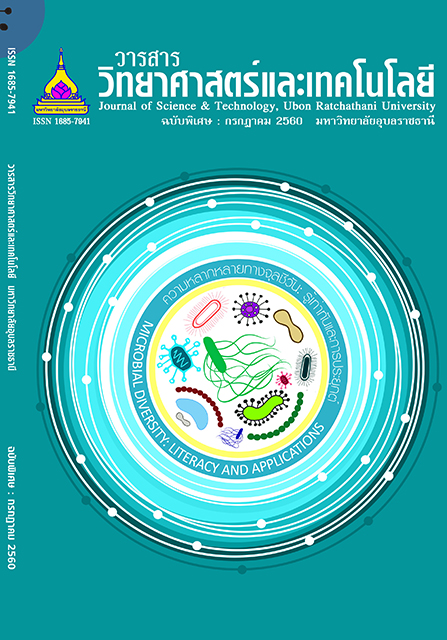การแยกและศึกษาลักษณะของไลติกเฟจ ที่จำเพาะต่อ Escherichia coli ที่ดื้อยาปฏิชีวนะ
Main Article Content
บทคัดย่อ
บทคัดย่อ
วัตถุประสงค์ของการศึกษานี้ คือ เพื่อแยกและศึกษาคุณสมบัติของไลติกเฟจที่จำเพาะต่อ Escherichia coli ดื้อยาปฏิชีวนะชนิด extended spectrum beta-lactamase Escherichia coli (ESBL-E. coli) โดยทำการแยก แบคเทอริโอเฟจ จากน้ำและน้ำเสียโดยวิธี enrichment method และ double agar layer method จากการทดลองสามารถแยกแบคเทอริโอเฟจได้ 7 ชนิด/หรือไอโซเลตจากตัวอย่างน้ำต่างชนิดกัน โดยตั้งชื่อแบคเทอริโอเฟจที่แยกได้ว่า EP1, EP2, EP3, EP4, EP5, EP6 และ EP7 ตามลำดับ การศึกษาความสามารถในการบุกรุกแบคทีเรียทดสอบ 17 ชนิดของแบคเทอริโอเฟจโดยวิธี spot test พบว่า แบคเทอริโอเฟจทุกไอโซเลตที่แยกได้ (ยกเว้น EP2) สามารถบุกรุกแบคทีเรียได้มากกว่าหนึ่งชนิด เมื่อนำแบคเทอริโอเฟจไปศึกษารูปร่างภายใต้กล้องจุลทรรศน์อิเล็กตรอนแบบส่องผ่านพบว่า แบคเทอริโอเฟจทุกไอโซเลตเป็นแบคเทอริโอเฟจใน order Caudovirales โดย แบคเทอริโอเฟจ EP1, EP2, EP3, EP5, EP6 and EP7 จัดอยู่ใน family Siphoviridae และแบคเทอริโอเฟจ EP4 จัดอยู่ใน family Podoviridae การศึกษา one-step growth experiment ทำให้ทราบค่า latent period, burst time และ burst size ของแบคเทอริโอเฟจแต่ละไอโซเลต การศึกษาสารพันธุกรรมของแบค เทอริโอเฟจพบว่า แบคเทอริโอเฟจทุกไอโซเลตมีสารพันธุกรรมเป็น double-stranded DNA และสามารถตัดได้ด้วยเอนไซม์ EcoRI จากการศึกษารูปแบบ DNA ที่ถูกตัดด้วยเอนไซม์โดยวิธี agarose gel electrophoresis และการศึกษารูปแบบโปรตีนโดยวิธี SDS-PAGE ของแบคเทอริโอเฟจพบว่า แบคเทอริโอเฟจที่แยกได้ทั้งหมดเป็นคนละชนิดกัน ซึ่งบ่งบอกถึงความหลากหลายของแบคเทอริโอเฟจที่แยกได้
คำสำคัญ : ไลติกเฟจ Escherichia coli ดื้อยาปฏิชีวนะ การรักษาโรคด้วยแบคเทอริโอเฟจ
Abstract
The objective of this study was to isolate and characterize lytic phages capable of infecting extended spectrum beta-lactamase Escherichia coli (ESBL-E. coli). Bacteriophages were isolated from water and wastewater samples using an enrichment protocol and the double agar layer method. Seven bacteriophages from different water samples were detected. They were named EP1, EP2, EP3, EP4, EP5, EP6 and EP7, respectively. The host ranges of the 7 bacteriophages were determined by performing spot tests with 17 bacterial strains. All bacteriophages, except EP2, infected more than one bacterial host. Transmission electron microscopy revealed the bacteriophages belonged to the order Caudovirales. Bacteriophage EP1, EP2, EP3, EP5, EP6 and EP7 were members of the family Siphoviridae, but bacteriophage EP4 belonged to the family Podoviridae. One-step growth experiment was employed to determine a latent period, a burst time and a burst size of each bacteriophage. All bacteriophages had a double-stranded DNA which was digested with EcoRI. DNA restriction patterns by agarose gel electrophoresis and protein profiles by SDS-PAGE of the bacteriophages showed the diversity among the isolated bacteriophages.
Keywords: Lytic phages; Antibiotic-resistant Escherichia coli; Phage therapy
Article Details
บทความที่ได้รับการตีพิมพ์เป็นลิขสิทธิ์ของ วารสารวิทยาศาสตร์และเทคโนโลยี มหาวิทยาลัยอุบลราชธานี
ข้อความที่ปรากฏในบทความแต่ละเรื่องในวารสารวิชาการเล่มนี้เป็นความคิดเห็นส่วนตัวของผู้เขียนแต่ละท่านไม่เกี่ยวข้องกับมหาวิทยาลัยอุบลราชธานี และคณาจารย์ท่านอื่นๆในมหาวิทยาลัยฯ แต่อย่างใด ความรับผิดชอบองค์ประกอบทั้งหมดของบทความแต่ละเรื่องเป็นของผู้เขียนแต่ละท่าน หากมีความผิดพลาดใดๆ ผู้เขียนแต่ละท่านจะรับผิดชอบบทความของตนเองแต่ผู้เดียว

